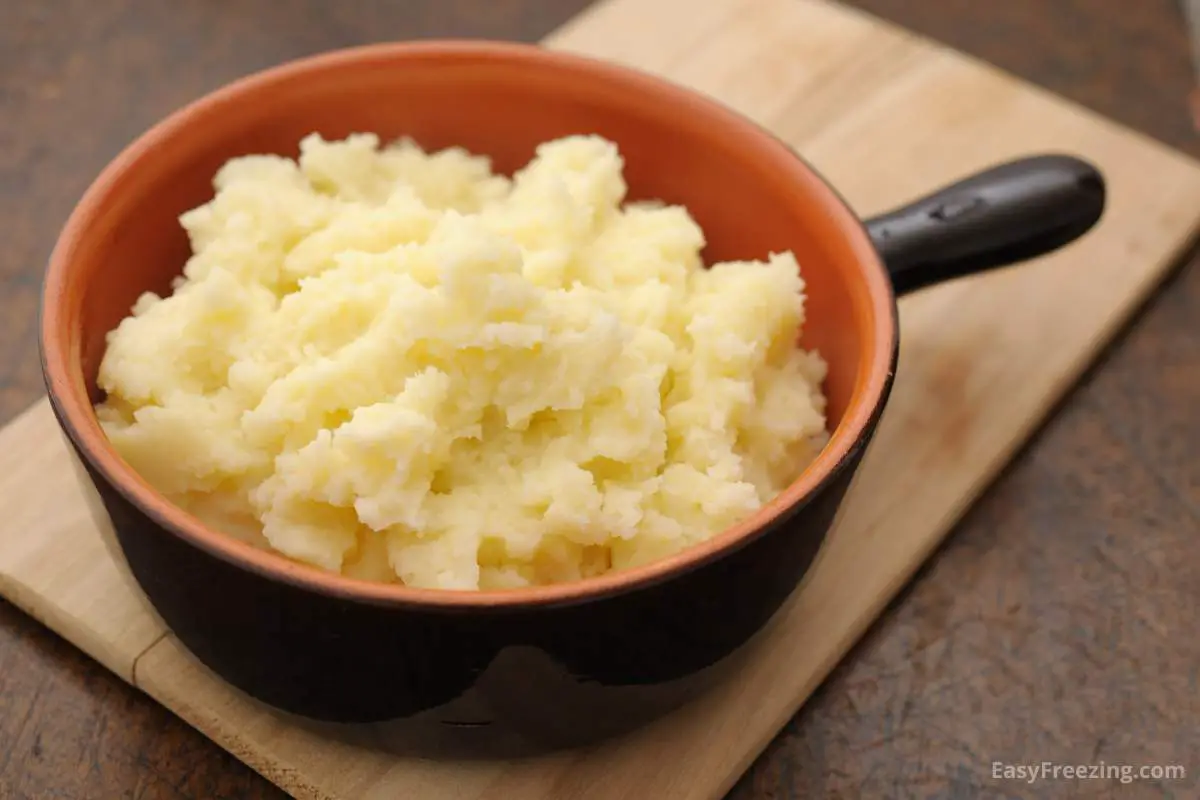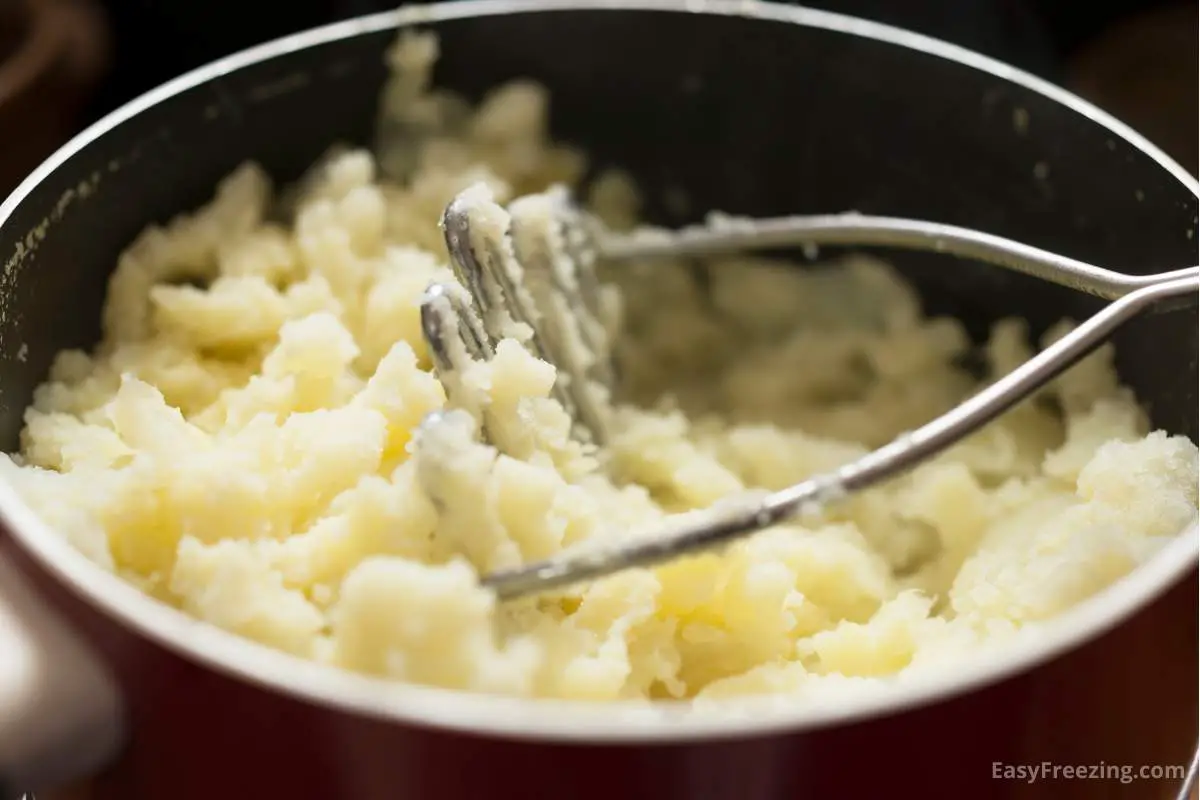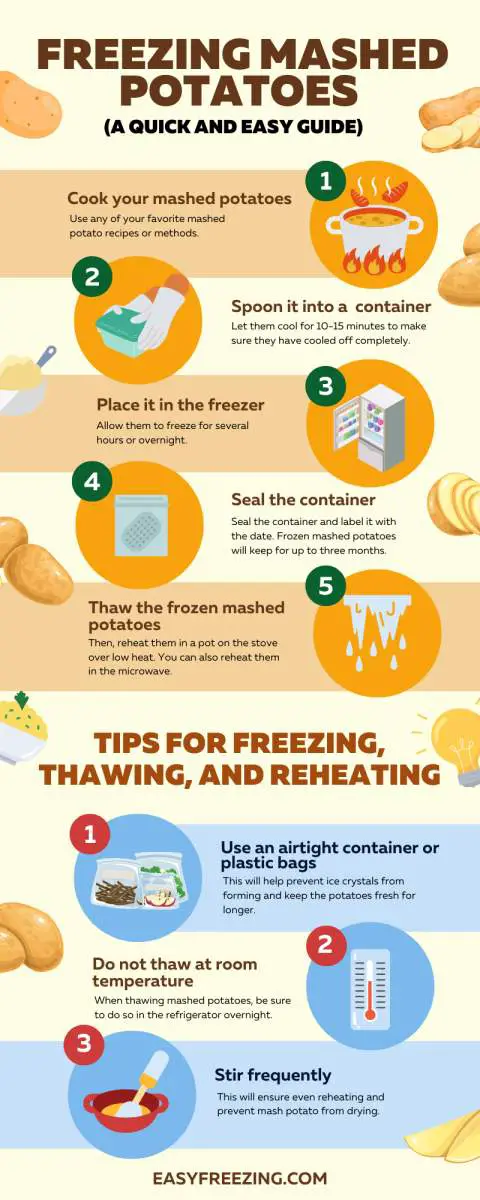Freezing Mashed Potatoes (A Quick & Easy Guide)
There are many reasons to freeze mashed potatoes. Maybe you made a large batch and didn’t want it to go to waste. Or maybe you’re looking for a quick and easy way to have mashed potatoes on hand for future meals. Whatever the reason, freezing mashed potatoes is a great option.
In this article, I will give you a step-by-step guide on how to freeze mashed potatoes. I’ll also provide some tips on thawing and reheating frozen mashed potatoes. So whether you’re looking to freeze leftover mashed potatoes or make a big batch ahead of time, read on for everything you need to know.

Making Mashed Potatoes and Freezing Them (4 Steps)
Making a big batch of mashed potatoes is one of the best ways to save time during the week. And while you could simply make a new batch of mashed potatoes, sometimes it’s nice to have them pre-prepared in order to save time. That’s where freezing comes in.
You can freeze your mashed potatoes with just a few simple steps, so they’re ready to go when you need them. Here’s how to do it:
Step 1: Make a Batch of Mashed Potatoes
Use your favorite mashed potato recipe or methods for cooking your potatoes as you normally would. Stir in any desired mix-ins. This is the time to include additional ingredients like shredded cheese, cooked bacon, or green onions.
You can toss in cream cheese or sour cream cheese as well if you like.

Step 2: Put The Mashed Potatoes Into a Container
Once the mashed potatoes have cooled completely, spoon them into a freezer-safe container. You don’t want to put hot potatoes in the freezer as this can cause the warm water vapor to freeze and create soupy potatoes when thawed. Let them cool for 15-30 minutes to ensure they have cooled off completely.
Leave about an inch of space at the top of the container to allow for expansion. You can freeze individual portions in separate freezer bags as well. This will enable you to thaw only the amount of mashed potatoes that you need at any given time.
Flash Freezing (Alternative)
Another way to go about this step would be to flash freeze the mashed potatoes. To do this, use a baking sheet covered in parchment or wax paper and spoon individual serving sizes of potatoes on top.
Make sure that the portions are spaced out so that they are not touching and won’t stick together when they freeze.
Place the tray into the freezer for 2 to 3 hours to complete the initial freeze. Once the portions of mashed potatoes are frozen solid, they can be removed from the freezer and placed into a freezer bag or container.
Flash freezing mashed potatoes in this way has the benefit of a faster freezing process which helps to preserve the taste and texture of the potatoes, and it’s a handy way to create portion sizes.
Step 3: Place The Mashed Potatoes in The Freezer
Seal the container and label it with the date. Place the container(s) of mashed potatoes in the freezer and allow them to freeze. Frozen mashed potatoes will last for up to three months.
Step 4: Thaw and Eat
When ready to eat, thaw the frozen mashed potatoes by placing them in the refrigerator overnight. Then, reheat them in a pot on the stove over low heat, occasionally stirring until they’re warm. You can also reheat them in the microwave.
Making Low Fat Mashed Potatoes (Better For Freezing)

People are often concerned about freezing mashed potatoes because they contain dairy and dairy ingredients often don’t freeze very well.
Fortunately, you can easily make a low-fat version of frozen mashed potatoes by substituting the milk and cream for low-fat milk or unsweetened almond milk. You can also use low-fat sour cream or yogurt instead of full-fat sour cream.
If you’re worried about a loss of flavor without these ingredients, you can always add additional sour cream, butter, yogurt, milk, etc. when thawing and reheating.
By making a lower-fat version of any mashed potato recipe, you can mostly eliminate the concern about the separation of dairy-based ingredients when freezing the potatoes.
Tips for Freezing, Thawing, & Reheating Frozen Mashed Potatoes
When it comes to freezing mashed potatoes, there are a few tips and considerations you’ll want to keep in mind to best preserve the potato’s taste and consistency.
Freeze Mashed Potatoes in an Airtight Container
Simply freezing mashed potatoes using an airtight container is the best way. This will help prevent freezer burn and keep the potatoes fresh for longer. You can also freeze mashed potatoes in a plastic freezer bag.
If using a plastic container, wrap the potatoes tightly with clingfilm or another layer of plastic wrap to prevent freezer burn.
When using a freezer bag, make sure to squeeze out as much air as possible before sealing.
Leave Some Space at The Top of The Container
When freezing mashed potatoes, leave about an inch of space at the top of the container. This will allow the potatoes to expand as they freeze without breaking the container.
Freeze Individual Serving Sizes of Mashed Potatoes
If you want to freeze individual servings of mashed potatoes, a muffin tray is a great option. Simply spoon the mashed potatoes into the muffin tray, then place the tray in the freezer. Once the potatoes are frozen, remove them from the tray and store them in a freezer bag.
Alternatively, you can use a parchment-lined baking sheet to freeze individual portions. This way, you can thaw and reheat only as much as you need.
Label Your Mashed Potato
Once your mashed potatoes are in an airtight container, label them with the date and place them in the freezer. Frozen mashed potatoes can be stored for up to three months.
Add Flavoring To Mashed Potatoes After Thawing
To prevent the mashed potatoes from becoming watery, adding any seasoning after they have been thawed is best. This includes ingredients like shredded cheese, cooked bacon, green onions, and garlic.
Reheat The Mashed Potatoes Carefully
When reheating frozen mashed potatoes, do so slowly and over low heat. This will help to prevent the thawed potatoes from becoming watery or mushy. You can also reheat mashed potatoes in the microwave. In this case, it’s best to use the defrost setting so the potatoes thaw more evenly.

How To Reheat Frozen Mashed Potatoes
When ready to use your frozen mashed potatoes, thaw them in the refrigerator overnight. Once thawed, you can reheat mashed potatoes in the microwave or stovetop.
To reheat in the microwave, place frozen mash potatoes in a microwave-safe bowl and heat them on high heat for two to three minutes. Stir the potatoes occasionally during reheating. Always use a microwave-safe dish for safe reheating.
To reheat mashed potatoes on the stovetop, place the potatoes in a small pot over medium heat. Stirring reguarly, heat the potatoes until they’re warm throughout.
How Long Do Mashed Potatoes Last in the Freezer?
Mashed potatoes freeze easily and last in the freezer for up to three months. However, for the best quality, it is ideal to use them within the first month or two.
Can You Freeze Mashed Potatoes With Milk?
You can freeze mashed potatoes with a little butter or milk, but it’s unnecessary. The milk may separate from the potatoes when thawed, so it’s best to add it after the potatoes have been reheated. You can also add cream or sour cream cheese after reheating them.
Freezing Mashed Potatoes – Final Thoughts
With these tips in mind, you’ll be able to freeze, thaw, reheat and serve your mashed potatoes easily, without worrying about the taste and texture. So go ahead and make a big batch ahead of time. Or freeze your leftover mashed potatoes for a quick and easy crowd-pleasing meal later on. Either way, you can’t go wrong.




